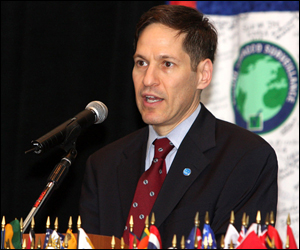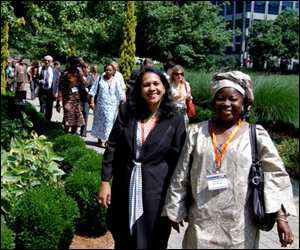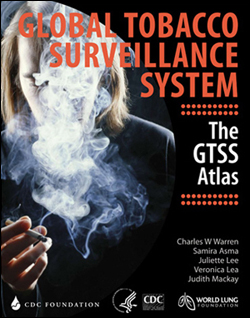Global Tobacco Surveillance System Serves as Worldwide Standard
Published: July 17, 2009

CDC Director Tom Frieden, MD, MPH, addresses the GTSS conference attendees. Photo by Caroline Joe
Think globally, act locally," the saying goes. New Centers for Disease Control and Prevention (CDC) Director Tom Frieden, MD, MPH, has done both, acting "locally" by instituting one of the strongest tobacco control programs in the country as New York City health commissioner, and globally, through leadership of the Bloomberg Initiative to Reduce Tobacco Use. It was fitting, therefore, that beginning his new job as director just so happened to coincide with a meeting in Atlanta of 128 countries active in CDC's Global Tobacco Surveillance System.
The Global Tobacco Surveillance System (GTSS) began 10 years ago through a partnership of the World Health Organization (WHO), CDC, and the Canadian Public Health Association in an effort to enhance the capacity of countries to design, implement, and evaluate their national comprehensive tobacco action plan and to monitor the key articles of the WHO Framework Convention on Tobacco Control.
The WHO Framework Convention on Tobacco Control (FCTC) is the first treaty negotiated under the auspices of the World Health Organization. It was adopted by the World Health Assembly in 2003 and has since become one of the most widely embraced treaties in UN history and, as of today, has been ratified by over 160 member states (the US has not ratified). Main provisions of FCTC relate to:
- Regulation (of tobacco products, packaging, promotion and smoking in public places),
- Reduction in consumer demand (through price and tax measures, education and assistance with quitting), and
- Protection of the environment and health of tobacco workers.
Samira Asma, MD, MPH, and Wick Warren, PhD, have been with the GTSS every step of the way.
"A key area of focus and reward with GTSS has been in developing and maintaining partnerships, said Asma. "Partnerships are key to achieving a sustained infrastructure on which well-designed systems rest. We continue to strive toward promoting partnerships that are based on principles, values and standards."

Attendees at the Global Tobacco Surveillance System conference. Photo by Nathan Jones
The surveillance system includes four unique surveys:
Three school-based surveys:
- The Global Youth Tobacco Survey for students aged 13-15,
- The Global School Personnel Survey for teachers and administrators at the same schools conducting the Global Youth Tobacco Survey, and
- The Global Health Professions Students Survey for 3rd year medical, dental, nursing and pharmacy students.
One household-based survey:
- The Global Adult Tobacco Survey. Added in 2007, this survey resulted from a grant to the CDC Foundation provided by the Bloomberg Initiative to Reduce Tobacco Use. This survey will assist in the formulation, tracking and implementation of effective tobacco control interventions for adult populations.
"Developing a system that could serve as a worldwide standard and providing consistent training, country after country, over the last 10 years, has been really gratifying," said Warren. "Standard-setting and consistency have been a hallmark throughout the growth and history of GTSS."
In 2008, WHO developed a technical assistance package intended to help countries meet their commitments agreed upon in the articles of the Convention. Called MPOWER, the package contains the six most effective tobacco-control strategies proved to reduce and reverse the tobacco-related disease and death. As Frieden noted at the GTSS conference reception, "FCTC has created a solid framework for global tobacco prevention, and WHO's MPOWER helps countries fulfill the promise of FCTC by providing a package of the six most important and effective tobacco control policies."
The six strategies are:
Monitor tobacco use:
- Objective – Obtain nationally representative and population-based periodic data on key indicators of tobacco use for youth and adults.
Protect people from tobacco smoke:
- Objective – Completely smoke-free environments in all indoor public spaces and workplaces, including restaurants and bars.
Offer help to quit tobacco use:
- Objective – Easily accessible services to manage tobacco dependence clinically at 100 percent of primary healthcare facilities and through community resources.
Warn about the dangers of tobacco:
- Objective – High levels of awareness of the health risks of tobacco use across age groups, sexes, and places of residence; so that all people understand that the result of tobacco use is suffering, disfigurement, and early death.
Enforce bans on tobacco advertising, promotion and sponsorship:
- Objective – Complete absence of tobacco advertising, promotion and sponsorship.
Raise taxes on tobacco products:
- Objective – Progressively less affordable tobacco products.
CDC, as a WHO Collaborating Center for Global Tobacco Surveillance, focuses on the M in MPOWER. CDC is responsible for survey design and sample selection, training, fieldwork implementation procedures, data management and processing, and initial tabulation of the data.
CDC staff members who engage with countries and regions through the GTSS work through a process of three phases of workshops and technical assistance. Phase I is the Survey Workshop and covers the questionnaire content, sample design, field procedures, and general data management. Participants leave this workshop with a plan for conducting their survey, including:
- sample design
- questionnaire
- timeline
- budget
From 1999 through 2008 there have been more than 70 such workshops. Phase II is the Analysis Workshop in which the data is reviewed and analyzed, and countries leave this workshop with a draft of their country report, a timeline for completion of the report, and a plan for dissemination of their data. Since 1999, there have been in excess of 45 such workshops.
Phase III is the Program/Policy Workshop and the emphasis is on linking the data to the program and policy efforts within each country. These workshops have been held in most of the WHO regions.
Phase III received much of the focus at the recent global conference. Along with celebrating 10 years of global tobacco surveillance, the conference's theme is linking data into action. Participants worked regionally in a series of facilitated sessions to build consensus for regional strategies and to create regional action plans. In addition to tending to the urgent work at hand, the conference was a moment to celebrate the successes of the last 10 years and this was kicked off during a meeting with a "video salute" containing footage of interviews with many of country partners.

During the conference, a new "GTSS Atlas" was released as a result of the rich bank of country data collected under the surveillance system. Building on the model of other recent cancer and tobacco atlases, the GTSS Atlas compiles data into vivid maps and graphics that provide comparisons between regions and countries and give shape and meaning to the statistics. Yet another milestone was the introduction of GTSS Web applications which will allow users to generate data queries on key tobacco indicators and make comparisons across countries and WHO regions. Data are currently available for the main school-based survey, the Global Youth Tobacco Survey, but the Website will ultimately include data for the four surveys of the GTSS, as well.
"We never could have presumed this moment when CDC began this effort 10 years ago," said CDC Office on Smoking and Health Director Matt McKenna, MD, MPH. "Sometimes reality exceeds our expectations and even our imagination, and so I predict by 2018, the achievements in preventing the overwhelming scale of tragedies due to tobacco use will be beyond some of our wildest dreams."
For more information on GTSS, visit the global tobacco Website: http://www.cdc.gov/tobacco/global/gtss/.

